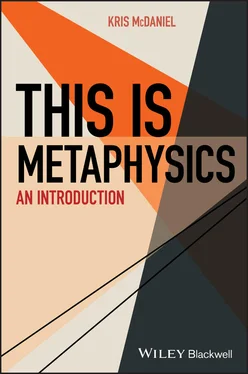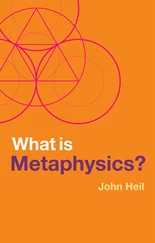1 Cover
2 AN INTRODUCTION TO THIS IS METAPHYSICS AN INTRODUCTION TO THIS IS METAPHYSICS
0.1 Who is This Book for? 0.2 Philosophy, Including Metaphysics, is for Everyone 0.3 An Overview of Metaphysics and Other Areas of Philosophy 0.4 Remarks for Instructors 0.5 Acknowledgments
3 1 CLASSIFICATION1.1 Introduction 1.2 Two Kinds of Classification 1.3 Classification Confusions 1.4 Do Things Objectively Belong Together? 1.5 Two Questions about Classification 1.6 Classification and Properties 1.7 Doing Metaphysics Further Reading
4 2 PROPERTIES 2.1 Introduction to the Metaphysics of Properties 2.2 Are Properties Theoretical Posits? 2.3 Issues in Language: Reference to Properties in Ordinary Speech 2.4 More Issues in Language: Properties as the Referents of Predicates 2.5 Issues in Metaphysics: Causation 2.6 Issues in Metaphysics: The Ontology of Events 2.7 Issues in Metaphysics: The Ontology of Material Objects 2.8 Tropes, Universals, and States of Affairs 2.9 Intrinsic and Extrinsic Properties 2.10 Perceptual Qualities 2.11 Doing Metaphysics Further Reading
5 3 PARTS AND WHOLES 3.1 Introduction 3.2 The Sufficiently Stuck Together Theory 3.3 The Mind‐Dependence Theory of Composition 3.4 Life is the Answer? 3.5 Vagueness 3.6 Vagueness and Composition 3.7 A Radical Answer to the Special Composition Question: Compositional Nihilism 3.8 Another Radical Answer: Compositional Universalism 3.9 Other Questions about Parts and Wholes 3.10 Doing Metaphysics Further Reading
6 4 POSSIBILITY AND NECESSITY 4.1 Introduction 4.2 Different Kinds of Possibility and Necessity 4.3 The Idea of Possible Worlds 4.4 A Case for Possible Worlds 4.5 Some Theories of the Nature of Possible Worlds 4.6 An Alternative Theory of Possible Worlds: Propositions First 4.7 Another Alternative Theory of Possible Worlds: Primitive Possible Objects 4.8 Accidental and Essential Features 4.9 Theories of Possible Worlds and Theories of Essential Features 4.10 Doing Metaphysics Further Reading
7 5 TIME 5.1 Introduction to the Philosophy of Time 5.2 Methodological Issues in the Philosophy of Time 5.3 The Container View vs. the Relationalist View 5.4 Does Time Itself Change? 5.5 Time and Reasonable Emotions 5.6 How Do Things Persist through Time? 5.7 Doing Metaphysics Further Reading
8 6 FREEDOM 6.1 Freedom and Why it Might Matter 6.2 The Static View and Freedom 6.3 Causal Determinism and Freedom 6.4 Compatibilism: Alternative Possibilities Compatibilism 6.5 Compatibilism 2: No Constraints Compatibilism 6.6 Indeterminism 6.7 Laws of Nature 6.8 Doing Metaphysics Further Reading
9 7 META‐METAPHYSICS7.1 Getting More Meta 7.2 The Epistemology of Metaphysics 7.3 The Philosophy of Language of Metaphysics 7.4 The Metaphysics of Metaphysics 7.5 The Ethics of Metaphysics 7.6 Doing Metaphysics Further Reading
10 GLOSSARY
11 INDEX
12 End User License Agreement
1 Chapter 2Figure 2.1 Two Puppy Pictures.Figure 2.2 Each of A, B, C, and D is composed of exactly three parts that ar...
2 Chapter 3Figure 3.1 Two Ways to Lift a Piano.
1 Cover
2 Table of Contents
3 Begin Reading
1 ii
2 iii
3 iv
4 v
5 1
6 2
7 3
8 4
9 5
10 6
11 7
12 8
13 9
14 10
15 11
16 12
17 13
18 14
19 15
20 16
21 17
22 18
23 19
24 20
25 21
26 22
27 23
28 24
29 25
30 26
31 27
32 28
33 29
34 30
35 31
36 32
37 33
38 34
39 35
40 36
41 37
42 38
43 39
44 40
45 41
46 42
47 43
48 44
49 45
50 46
51 47
52 48
53 49
54 50
55 51
56 52
57 53
58 54
59 55
60 56
61 57
62 58
63 59
64 60
65 61
66 62
67 63
68 64
69 65
70 66
71 67
72 68
73 69
74 70
75 71
76 72
77 73
78 74
79 75
80 76
81 77
82 78
83 79
84 80
85 81
86 82
87 83
88 84
89 85
90 86
91 87
92 88
93 89
94 90
95 91
96 92
97 93
98 94
99 95
100 96
101 97
102 98
103 99
104 100
105 101
106 102
107 103
108 104
109 105
110 106
111 107
112 108
113 109
114 110
115 111
116 112
117 113
118 114
119 115
120 116
121 117
122 118
123 119
124 120
125 121
126 122
127 123
128 124
129 125
130 126
131 127
132 128
133 129
134 130
135 131
136 132
137 133
138 134
139 135
140 136
141 137
142 138
143 139
144 140
145 141
146 142
147 143
148 144
149 145
150 146
151 147
152 148
153 149
154 150
155 151
156 152
157 153
158 154
159 155
160 156
161 157
162 158
163 159
164 160
165 161
166 162
167 163
168 164
169 165
170 166
171 167
172 168
173 169
174 170
175 171
176 172
177 173
178 174
179 175
180 176
181 177
182 178
183 179
184 180
185 181
186 182
187 183
188 184
189 185
190 186
191 187
192 188
193 189
194 190
195 191
196 192
197 193
198 194
199 195
200 196
201 197
202 198
203 199
204 200
205 201
206 202
207 203
208 204
209 205
210 206
211 207
212 208
213 209
214 210
215 211
216 212
217 213
218 214
219 215
220 216
221 217
222 218
223 219
224 220
225 221
226 222
227 223
228 224
229 225
230 226
231 227
232 228
233 229
234 230
235 231
236 232
237 233
238 234
239 235
240 236
241 237
242 238
243 239
244 240
245 241
246 242
247 243
248 244
249 245
250 246
251 247
252 248
253 249
254 250
255 251
256 252
257 253
258 254
259 255
260 256
261 257
262 258
263 259
264 260
265 261
266 262
267 263
268 264
269 265
270 266
271 267
 THIS IS PHILOSOPHY
THIS IS PHILOSOPHY
Series editor: Steven D. Hales
Reading philosophy can be like trying to ride a bucking bronco—you hold on for dear life while “transcendental deduction” twists you to one side, “causa sui” throws you to the other, and a 300‐word, 300‐year‐old sentence comes down on you like an iron‐shod hoof the size of a dinner plate. This Is Philosophy is the riding academy that solves these problems. Each book in the series is written by an expert who knows how to gently guide students into the subject regardless of the reader’s ability or previous level of knowledge. Their reader‐friendly prose is designed to help students find their way into the fascinating, challenging ideas that compose philosophy without simply sticking the hapless novice on the back of the bronco, as so many texts do. All the books in the series provide ample pedagogical aids, including links to free online primary sources. When students are ready to take the next step in their philosophical education, This Is Philosophy is right there with them to help them along the way.
Читать дальше

 THIS IS PHILOSOPHY
THIS IS PHILOSOPHY










